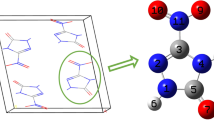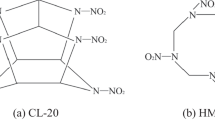Abstract
Molecular dynamic (MD) simulations were employed to investigate the hexanitrohexaazaisowurtzitane (CL-20) crystal, seven designed energetic poly-(phthalazinone ether sulfone ketones) (PPESKs) and PPESKs/ε-CL-20 polymer–bonded explosives (PBXs). Cohesive energy density (CED) and solubility parameters (δ) were predicted for PBXs, the results indicated that stability of PBXs are related to their cohesive energy density (CED). Mechanical properties of seven polymer-bonded explosives (PPESKs/ε-CL-20) were found improved in comparison with that of ε-CL-20 by adding polymer binders. Young’s modulus (E), Shear modulus (G), and Bulk modulus (K) declined compare with ε-CL-20. K/G ratio and Cauchy pressure C12-C44 of PBXs indicate that they have certain ductility. Radial distribution function (RDF) was utilized for analyzing the interactions between PPESKs and ε-CL-20, and results demonstrate that hydrogen bond and van der Waals interactions exist between polymers and ε-CL-20. The calculated oxygen balance of polymer-bonded explosives (PBXs) is lower than that of pure ε-CL-20 by nearly about − 24%. Detonation properties of the polymer-bonded explosives (PBXs) were predicted based on ε-CL-20 values. Detonation velocity (D) for these PBXs was predicted almost at about 8300 m s−1, and the detonation pressure (P) for these PBXs was all predicted nearly at 38 GPa.








Similar content being viewed by others
References
Shu YJ, Huo JC (2011) Theory of explosives. Chemical Industry, Bei**g
Ou YX, Liu JQ (2005) High energy density compounds. National Defense Industry, Bei**g
Klapöke TM (2007) High energy density materials. Springer-Verlag, Berlin
Foltz MF (1994) Thermal stability of ε-hexanitrohexaazaisowurtzitane in an estane formulation. Propell Explos Pyrot 19:63–69
Foltz MF, Coon CL, Garcia F, Nichols III AL (1994) The thermal stability of the polymorphs of hexanitrohexaazaisowurtzitane, part II. Propell Explos Pyrot 19:133–144
Wang Y, Song XL, Song D, Jiang W, Liu HY, Li FS (2013) A versatile methodology using sol-gel, supercritical extraction, and etching to fabricate a nitramine explosive: nanometer HNIW. J Energ Mater 31:49–59
Li J, Brill TM (2007) Kinetics of solid polymorphic phase transitions of CL-20. Propell Explos Pyrot 32(4):326–330
Simpson RL, Urtiew PA, Ornellas DL, Moody GL, Scribner KJ, Hoffman DM (1997) CL-20 performance exceeds that of HMX and its sensitivity is moderate. Propell Explos Pyrot 22:249–255
Ghosh M, Venkatesan V, Mandav S, Banerjee S, Sikder N, Sikder AK, Bhattacharya B (2014) Probing crystal growth of ε- and α-CL-20 polymorphs via metastable phase transition using microscopy and vibrational spectroscopy. Cryst Growth Des 14:5053–5063
Wei XF, Xu JJ, Li HZ, Long XP, Zhang CY (2016) Comparative study of experiments and calculations on the polymorphisms of 2,4,6,8,10,12-hexanitro-2,4,6,8,10,12-hexaazaisowurtzitane (CL-20) precipitated by solvent/antisolvent method. J Phys Chem C 120:5042–5051
Millar DIA, Maynard-Casely HE, Kleppe AK, Marshall WG, Pulham CR, Cumming AS (2010) Putting the squeeze on energetic materials-structural characterization of a high-pressure phase of CL-20. Cryst Eng Comm 12:2524–2527
Zhao XQ, Shi NC (1995) Crystal structure of ε-hexanitrohexaazaisowurtzitane. Chin Sci Bull 40:2158–2160
Bolton O, Matzger AJ (2011) Improved stability and smart-material functionality realized in an energetic cocrystal. Angew Chem Int Ed 50:8960–8963
Doblas D, Rosenthal M, Burghammer M, Chernyshov D, Spitzer D, Ivanov DA (2016) Smart energetic nanosized co-crystals: exploring fast structure formation and decomposition. Cryst Growth Des 16:432−439
Yan QL, Zeman S,Zhao FQ, Elbeih A (2013) Non-isothermal analysis of C4 bonded explosives containing different cyclic nitramines. Thermochim Acta 556:6−12
Yan QL, Zeman S, Elbeih A (2013) Thermal behavior and decomposition kinetics of viton A bonded explosives containing attractive cyclic nitramines. Thermochim Acta 562:56−64
Yan QL, Zeman S, Zhang TL, Elbeih A (2013) Non-isothermal decomposition behavior of fluorel bonded explosives containing attractive cyclic nitramines. Thermochim Acta 574:10−18
Li HR, Shu YJ, Gao SJ, Chen L, Ma Q, Ju XH (2013) Easy methods to study the smart energetic TNT/CL-20 co-crystal. J Mol Model 19:4909–4917
Sun T, Liu Q,**ao JJ, Zhao F, **ao HM (2014) Molecular dynamics simulation of interface interactions and mechanical properties of CL-20/HMX cocrystal and its based PBXs. Acta Chim Sinica 72:1036–1042
Han G, Li QF, Gou RJ, Zhang SH, Ren FD, Guan R(2017) Growth morphology of CL-20/HMX cocrystal explosive: insights from solvent behavior under different temperatures. J Mol Model 23:360
Wu ZK, Shu YJ et al. (2016) Molecular dynamics simulation of CL-20/FOX-7 co-crystal. insights from solvent behavior under different temperatures. Chin J Expl Propell 39(3):37–42
Zhu SF, Zhang SH, Gou RJ, Han G, Wu CL (2017) Theoretical investigation of the effects of the molar ratio and solvent on the formation of the pyrazole–nitroamine cocrystal explosive 3,4-dinitropyrazole (DNP)/2,4,6,8,10,12-hexanitrohexaazaisowurtzitane (CL-20). J Mol Model 23:353
Asay BW (2009) Non-Shock initiation of explosives. Springer, Berlin
Lundberg AW (1996) High Explosives in stockpile surveillance indicate constancy. Science & Technology Review (December):13–17
Zeman S, Elbeih A,Yan QL (2013) Note on the use of the vacuum stability test in the study of initiation reactivity of attractive cyclic nitramines in the P1 Matrix. J Therm Anal Calorim 111:1503−1506
Zeman S, Elbeih A, Yan QL (2013) Note on the use of the vacuum stability test in the study of initiation reactivity of attractive cyclic nitramines in the C4 Matrix. J Therm Anal Calorim 112:433−1437
Yuan LL, **ao JJ, Zhao F, **ao HM (2016) Molecular dynamics simulation of composites formed with e-CL-20 and PVA, PEG on different crystalline surfaces. Chin J Energ Mater 2:124–128
Tao J, Wang XF,Zhao SX, Wang CL, Diao XQ, Han ZX (2015) Simulation and calculation for binding energy and mechanical properties of e-CL-20/energetic polymer binder mixed system. Chin J Energ Mater 4:315–322
Wang JY, Jian XG (2016) Applications of high performance phthalazinone-containing pesins in insulating materials. Insulating Materials 49(10):17–23
Liu C, Jian XG (2011) Recent progress in thermoplastic composites based on poly(aryl ether)s containing phthalazinone moiety. Chin Polym Bull 9:52–62
Jian XG, Liao GX, Wang JY (2002) Research progress of poly-(arylene ether ketone)s and poly(arylene ether sulfone)s containing phthalazinone moieties. China Plastics 16:11–15
Wang JY, Jian XG (2011) Progress on synthesis of heterocyclic polymers containing phthalazinone moiety and the relationship of their structure and properties. Chin Polym Bull 9:22–34
Wang K, Shu YJ et al. (2017) Molecular dynamics simulations for performance of PPESK and PPESK/ε-CL-20 composite system. Chin J Expl Propell 40(4):38–43
Shu Y, Wang DT et al. (2018) Molecular dynamics simulation on the physical properties of the novel designed poly-(phthalazinone ether sulfone ketone) (PPESK). Comp Mater Sci 152:158–164
Shu Y, Yi Y et al. (2017) Interactions between poly-(phthalazinone ether sulfone ketone) (PPESK) and TNT or TATB in polymer bonded explosives: a molecular dynamic simulation study. J Mol Model 23:334
Xu XJ, **ao HM, **ao JJ, Zhu W, Huang H, Li JS (2006) Molecular dynamics simulations for pure ε-CL20 and ε-CL20-based PBXs. J Phys Chem B 110:7203–7207
Accelrys Software Inc Materials Studio Accelrys Software Inc San Diego
Akkermans RLC, Spenley NA, Robertson SH (2013) Monte Carlo codes, tools and algorithms Monte Carlo methods in materials studio. Mol Simulat 39:1153–1164
Andersen HC (1980) Molecular dynamics simulations at constant pressure and /or temperature. J Chem Phys 72:2384–2393
Berendsen HJC, Postma JPM, Gunsteren WF, DiNola A, Haak JR (1984) Molecular dynamics with coupling to an external bath. J Chem Phys 81:3684–3690
Allen MP, Tildesley DJ (1983) Computer simulation of liquids. Oxford University Press, Oxford
Sun H (1998) COMPASS: an ab initio force-field optimized for condensed-phase applications overview with details on alkane and benzene compounds. J Phys Chem B 102:7338–7364
Liu N, Zeman S, Shu YJ, Wu ZK, Wang BZ, Shi WY (2016) Comparative study of melting points of 3,4-bis(3-nitrofurazan-4-yl)furoxan (DNTF)/1,3,3-trinitroazetidine (TNAZ) eutectic compositions using molecular dynamic simulations. RSC Adv 6:59141–59149
Lu YY, Shu YJ et al. (2018) Molecular dynamics simulations on ε-CL-20-based PBXs with added GAP and its derivative polymers. RSC Adv 8:4955–4962
Abboud JLM, Notario R (1999) Critical compilation of scales of solvent parameters. Part I. pure, non-hydrogen bond donor solvents-technical report. Pure Appl Chem 71:645–718
Xu XJ, **ao HM, Ju XH, Gong XD (2005) Theoretical study on pyrolysis mechanism for ε-hexanitrohexaazaisowurtzitane. Chin J Org Chem 5:536–539
Qiu L, Zhu WH, **ao JJ, Zhu W, **ao HM, Huang H, Li JS (2007) Molecular dynamics simulations of trans-1,4,5,8-tetranitro-1,4,5,8-tetraazadecalin-based polymer-bonded explosives. J Phys Chem B 111:1559–1566
Watt JP, Davies GF, O'Connell RJ (1976) The elastic properties of composite materials. Rev Geophys Space Phys 14:541–563
Weiner JH, Milstein F (1983) Statistical mechanics of elasticity. Wiley, New York
Landau LD, Lifshitz EM (1986) Theory of elasticity. Pergamon, Oxford
Rudolf M, Köhler J, Homburg DIA (2007) Explosives, 6th Ed. Wiley-VCH, Weinheim
Zhang HS (1982) Oxygen balance of the organic elements explosives. Acta Armamentarh 2:61–63
Wu X (1985) Simple method for calculating detonation parameters of explosives. Chin J Energ Mater 3:263–277
Kamlet MJ, Jacobs SJ (1968) Chemistry of detonations I. A simple method for calculating detonation properties of C-H-N-O explosives. J Chem Phys 48:23–35
Keshavarz MH, Motamedoshariati H, Moghayadnia R, Nazari HR, Azarniamehraban J (2009) A new computer code to evaluate detonation performance of high explosives and their thermochemical properties, part I. J Hazard Mater 172:1218–1228
Duan M, Xu GG, Wang YZ (1992) The detonation model and calculation of mixed explosives. Blasting 1:26–28
Hang GY, Yu WL, Wang T, Wang JT, Li Z (2017) Theoretical insights into the effects of molar ratios on stabilities, mechanical properties, and detonation performance of CL-20/HMX cocrystal explosives by molecular dynamics simulation. J Mol Model 23:30
Zeman S (2007) Sensitivities of high energy compounds. Struct Bonding 125:195–271
Storm CB, Stine JR, Kramer JF (1990) Sensitivity relationships in energetic materials, chemistry and physics of energetic materials. Kluwer, Dordrecht
Pepekin VI, Korsunskii BL, Denisaev AA (2008) Initiation of solid explosives by mechanical impact. Combust Explos Shock Waves 44:586–590
Pospišil M, Vavra P, Concha MC, Murray JS, Politzer P (2011) Sensitivity and the available free space per molecule in the unit cell. J Mol Model 17:2569–2574
Politzer P, Murray JS (2014) Impact sensitivity and crystal lattice compressibility/free space. J Mol Model 20:2223
Murray JS, Lane P, Politzer P (1998) Effects of strongly electron-attracting components on molecular surface electrostatic potentials: application to predicting impact sensitivities of energetic molecules. Mol Phys 93:187–194
Politzer P, Murray JS (2016) High performance, low sensitivity: conflicting or compatible? Propell Explos Pyrot 41:414–425
Funding
Authors appreciate the financial support from the National Natural Science Foundation of China (grant nos. 21673018 and 21703168), Science and Technology Program of Guangzhou (2016201604030043, China), and Sichuan University of Science and Engineering (2017RCL44).
Author information
Authors and Affiliations
Corresponding authors
Ethics declarations
Conflicts of interest
The authors declare that they have no conflict of interest.
Additional information
Publisher’s Note
Springer Nature remains neutral with regard to jurisdictional claims in published maps and institutional affiliations.
Rights and permissions
About this article
Cite this article
Shu, Y., Zhang, S., Shu, Y. et al. Interactions and physical properties of energetic poly-(phthalazinone ether sulfone ketones) (PPESKs) and ε-hexanitrohexaazaisowurtzitane (ε-CL-20) based polymer bonded explosives: a molecular dynamics simulations. Struct Chem 30, 1041–1055 (2019). https://doi.org/10.1007/s11224-018-1225-y
Received:
Accepted:
Published:
Issue Date:
DOI: https://doi.org/10.1007/s11224-018-1225-y




